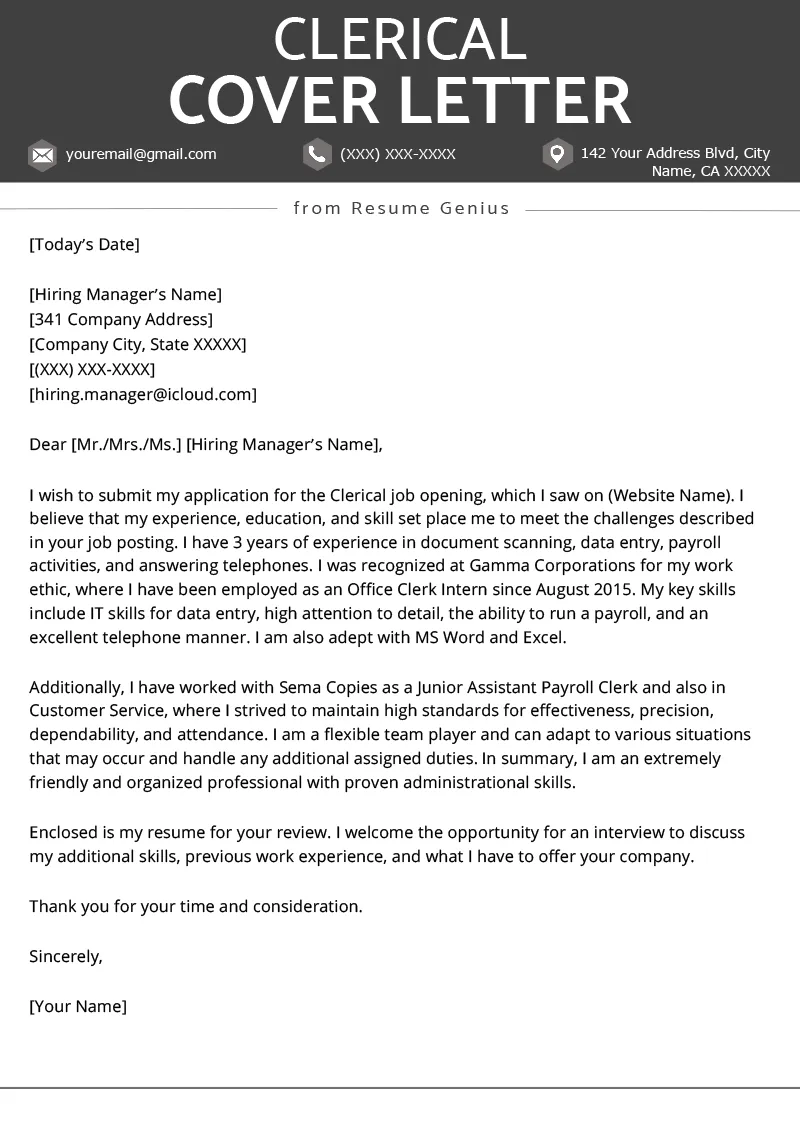What is a Clerical Job Cover Letter
A clerical job cover letter is a crucial document that accompanies your resume when applying for clerical positions. It serves as your introduction to the hiring manager, providing an opportunity to showcase your skills, experience, and enthusiasm for the role. Unlike your resume, which presents a factual summary of your qualifications, a cover letter allows you to express your personality and explain why you are the perfect fit for the specific clerical job. It’s your chance to make a strong first impression and persuade the employer to read your resume and consider you for an interview. A well-crafted cover letter highlights your key strengths and demonstrates your understanding of the job requirements, increasing your chances of getting hired. The aim is to make a solid first impression to the hiring manager, encouraging them to read your resume and invite you for an interview.
Why You Need a Stellar Clerical Cover Letter
In a competitive job market, a stellar clerical cover letter can make all the difference. It’s your opportunity to differentiate yourself from other applicants and demonstrate why you are the ideal candidate. Many hiring managers first review cover letters to assess a candidate’s communication skills, attention to detail, and overall suitability for the role. A well-written cover letter highlights your key strengths, demonstrates your understanding of the job requirements, and showcases your personality. A generic or poorly written cover letter can immediately disqualify you, so investing time and effort into crafting a compelling letter is essential for success in your job search. A cover letter that is customized for each position you are applying for will show the hiring manager that you have researched the role and organization, and are genuinely interested in the opportunity.
Key Components of a Winning Clerical Cover Letter

A winning clerical cover letter consists of several key components, each playing a vital role in capturing the hiring manager’s attention and making a positive impression. These components work together to create a cohesive and compelling narrative that showcases your qualifications and enthusiasm for the position. Mastering these elements will greatly enhance your chances of success in your job search. From the header to the closing, each section must be carefully crafted to leave a lasting positive impression. Remember that the overall goal is to persuade the hiring manager that you are the best fit for the job, so keep that in mind when crafting each component.
Header Information
Your Contact Information
Your header should begin with your contact information, ensuring the hiring manager can easily reach you. This typically includes your full name, phone number, email address, and optionally, your LinkedIn profile URL. Ensure your email address is professional. Avoid using nicknames or unprofessional email addresses. This information should be clearly formatted, usually at the top of the letter, on the left or right side. Double-check that the information is accurate and up-to-date, as a simple mistake can prevent a recruiter from reaching you. Providing multiple contact methods, like both a phone number and email, increases the chance of being contacted for an interview.
Date and Employer’s Information
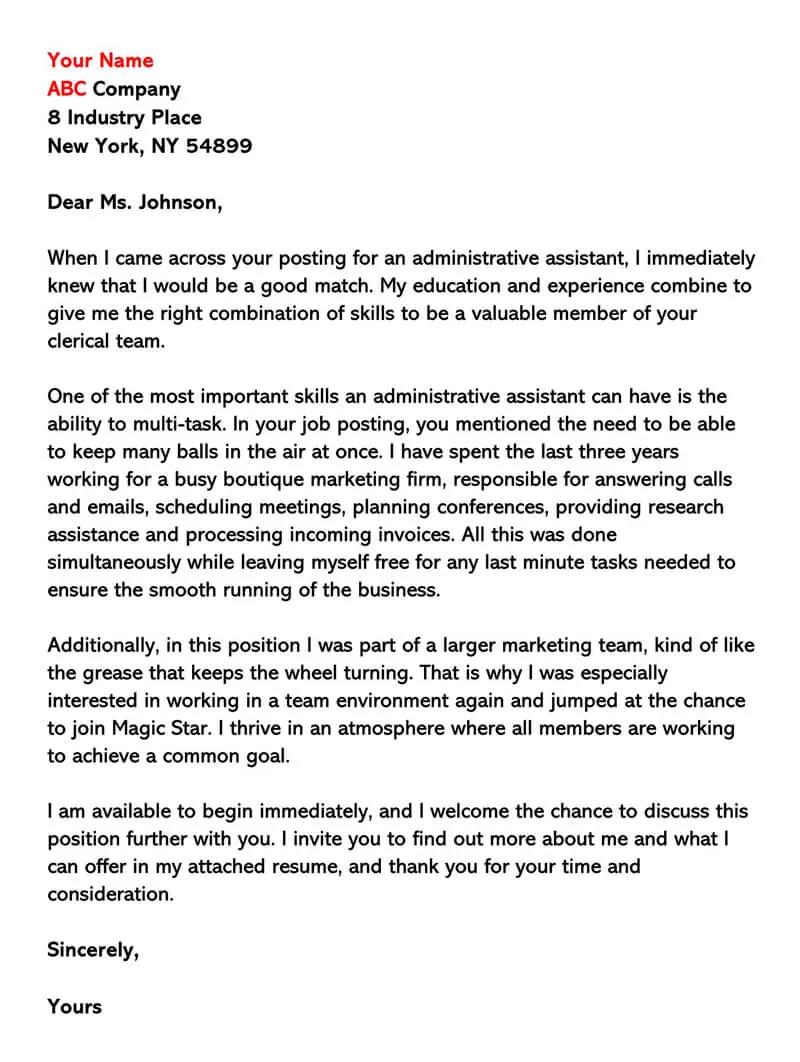
Following your contact information, include the date and the employer’s details. This helps the hiring manager quickly identify the letter’s origin. Include the date of submission, the recipient’s name (if known, otherwise use the hiring manager’s title), the company name, and the company’s address. If you are unsure of the hiring manager’s name, research the company’s website or use a general greeting, such as ‘Dear Hiring Manager’. Ensure that all this information is properly formatted and aligns with professional business letter standards. This part of the header not only looks professional but also helps the recipient understand the context of the letter immediately.
Salutation
Start your cover letter with a professional salutation. Whenever possible, address the hiring manager by name. Research the company’s website or use LinkedIn to find the name of the hiring manager or the person responsible for hiring. A personalized greeting shows that you have taken the time to research the company and are genuinely interested in the position. Use a formal greeting like ‘Dear Mr./Ms. [Last Name]’. If you are unable to find a specific name, use a general salutation, such as ‘Dear Hiring Manager’. Avoid using overly casual greetings, as they can be perceived as unprofessional. The salutation sets the tone for the entire letter, so it is important to get it right from the start.
Body Paragraph 1 Introduction and Hook
The first body paragraph should introduce you and immediately capture the hiring manager’s attention. Start by stating the position you are applying for and where you saw the job posting. Then, briefly mention your most relevant skills or experience that align with the job requirements. This initial statement should be concise and engaging, serving as a ‘hook’ to encourage the reader to continue. Explain your enthusiasm for the position and the company. This shows your proactive approach and makes a positive first impression. Highlighting a key achievement or skill can also serve as an effective hook. The goal is to make a strong first impression and encourage the hiring manager to read the rest of your letter.
Highlighting Relevant Skills and Experience
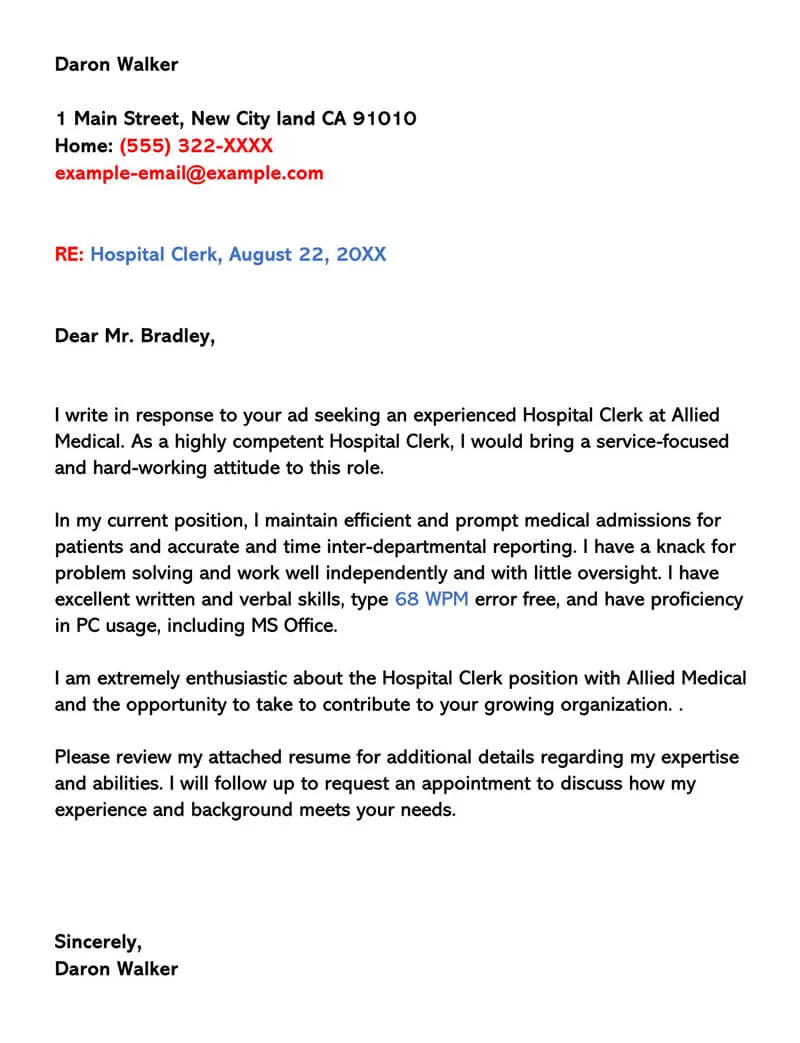
The main body of your cover letter is where you elaborate on your skills and experience, aligning them with the job requirements. Carefully review the job description and identify the key skills and qualifications the employer is seeking. Use specific examples to illustrate how you have demonstrated these skills in previous roles. Provide evidence of your ability to perform the tasks outlined in the job description. Be concise and focus on the most relevant aspects of your background. Use action verbs to describe your accomplishments and contributions. Show, don’t just tell, by providing concrete examples of your achievements. This part is where you convince the hiring manager that you are the ideal candidate.
Quantifying Achievements
Whenever possible, quantify your achievements. Instead of simply stating that you have improved efficiency, provide specific metrics, such as ‘increased office efficiency by 15%’ or ‘reduced processing time by 20%’. Numbers and data provide concrete evidence of your impact in previous roles and demonstrate the value you can bring to the new position. Use quantifiable results to strengthen your claims. This also provides the employer with a clear understanding of your past successes and potential future performance. Consider using bullet points to present your achievements in a clear and easy-to-read format, making it easier for the hiring manager to grasp the impact of your work. Quantifiable achievements are a powerful way to make your cover letter stand out.
Tailoring Your Letter to the Job Description
Tailoring your cover letter to the job description is crucial for demonstrating that you are a good fit for the role. Carefully read the job description and highlight the keywords and requirements the employer has listed. Then, integrate these keywords into your letter, showing how your skills and experience align with these specific needs. Customize your letter to match the unique requirements of each position you apply for. Doing so will show the hiring manager that you have taken the time to understand the job and are genuinely interested in the opportunity. A tailored cover letter shows your commitment to the role, making your application more impactful. Highlighting relevant qualifications in your cover letter shows you understand the job’s demands and are prepared to meet them.
Body Paragraph 2 Demonstrating Enthusiasm and Fit
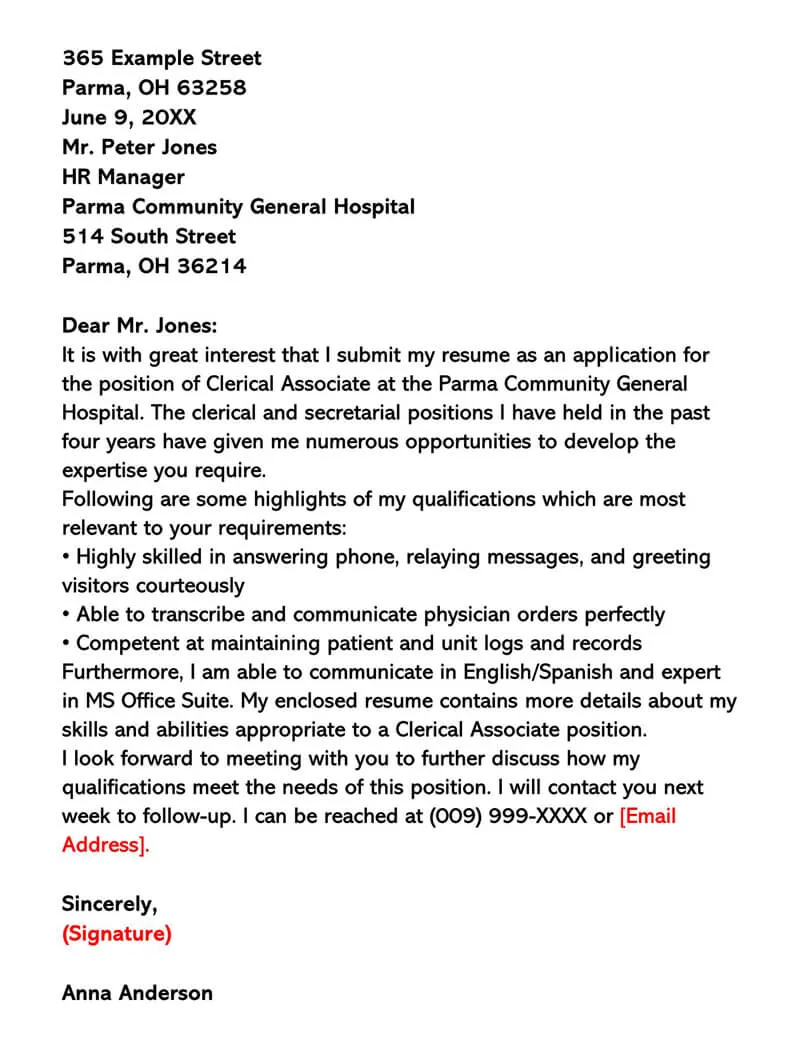
In the second body paragraph, express your enthusiasm for the position and the company. Explain why you are interested in this specific role and what attracts you to the organization. Show that you have researched the company and understand its mission, values, and culture. Mentioning specific projects or initiatives that resonate with you can further demonstrate your interest. Highlight how your personal and professional values align with the company’s, creating a sense of mutual fit. This helps the hiring manager see that you are not just looking for a job, but a career, and that you are genuinely excited about the opportunity. Demonstrating enthusiasm will make your cover letter more compelling and memorable. It’s important to show that you would be a positive addition to the team.
Body Paragraph 3 Call to Action and Closing
The final body paragraph should include a call to action and a professional closing. State your interest in an interview and how you look forward to discussing your qualifications further. Provide your contact information again and thank the hiring manager for their time and consideration. This is a polite and proactive way to end your letter, prompting the employer to move forward with the hiring process. Ensure the closing is professional and appropriate, like ‘Sincerely’ or ‘Respectfully’. Reiterate your enthusiasm for the opportunity and reinforce your interest in the role. A strong call to action encourages the employer to take the next step. This is your final chance to make a lasting impression, so make sure to end on a positive and confident note.
Complimentary Close and Signature
End your cover letter with a professional complimentary close and your signature. Use a formal closing, such as ‘Sincerely,’ ‘Regards,’ or ‘Best regards,’ followed by your typed name. If you are submitting a digital cover letter, you may choose to include a digital signature or leave space for your handwritten signature if you are printing the letter. The complimentary close should reflect the tone of the letter. This is the final touch and helps to create a polished and professional impression. Ensure your contact information is easily accessible and that the closing reinforces your interest in the role. Always proofread the entire letter before submitting it. A well-crafted closing leaves a positive, lasting impression.
Clerical Cover Letter Examples
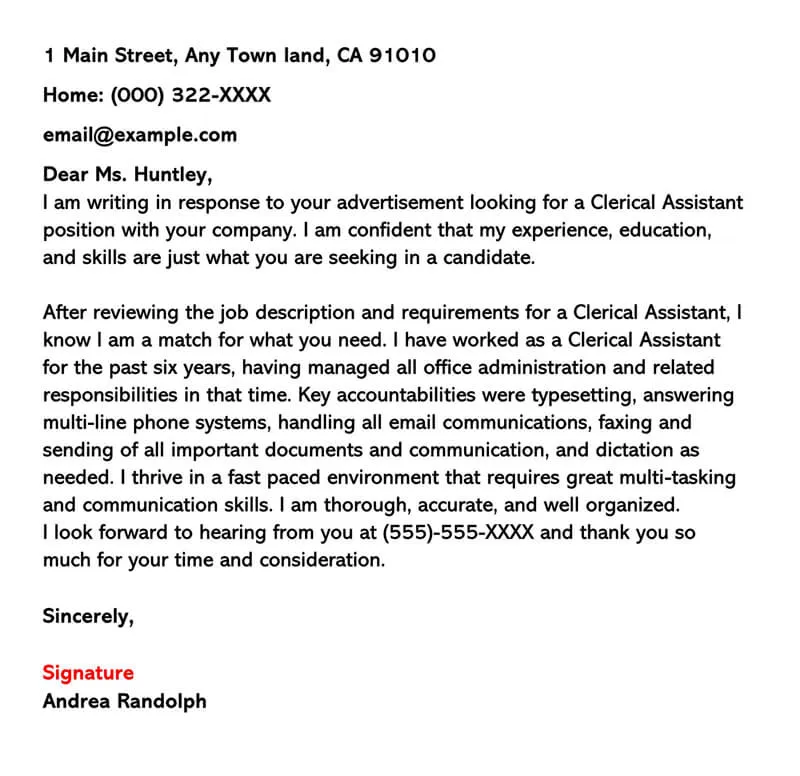
Reviewing examples of clerical cover letters can help you understand how to effectively present your qualifications and experience. These examples provide inspiration and guidance when crafting your own letter. Analyzing these examples will allow you to identify effective strategies, key phrases, and formatting techniques that resonate with hiring managers. Tailor these examples to match your own individual qualifications and the specific requirements of the job you are applying for. Remember to customize these examples and align them with your own background and the specific job requirements to show that you understand what the employer is seeking. Here are a few examples based on different experience levels and situations.
Example 1 Entry-Level Clerical Position
This example provides guidance for recent graduates or individuals with limited clerical experience. Focus on highlighting relevant skills from academic projects, volunteer work, or internships. Emphasize your eagerness to learn and contribute to the organization, and express your commitment to developing your clerical skills. Mention any coursework related to office management, communication, or data entry. Tailor the letter to demonstrate your potential and your eagerness to start your career. This entry-level example emphasizes transferable skills, a strong work ethic, and a genuine interest in the role, helping you to make a positive first impression and increase your chances of getting hired. Use this as a guide for formatting your letter and framing your qualifications.
Example 2 Experienced Clerical Professional
For experienced professionals, the focus should be on showcasing your achievements and skills in past roles. Provide quantifiable accomplishments to demonstrate your value and highlight your experience. Use this opportunity to explain how your skills align with the job requirements and make you the best candidate. Tailor your cover letter to showcase skills like data entry, filing, managing communications, and assisting management, demonstrating your ability to handle the job responsibilities. Highlight your achievements and the impact you have made in previous roles. A well-crafted cover letter like this will highlight your experience and demonstrate that you are capable and ready to take on the new challenges.
Example 3 Clerical Position with Specific Skills
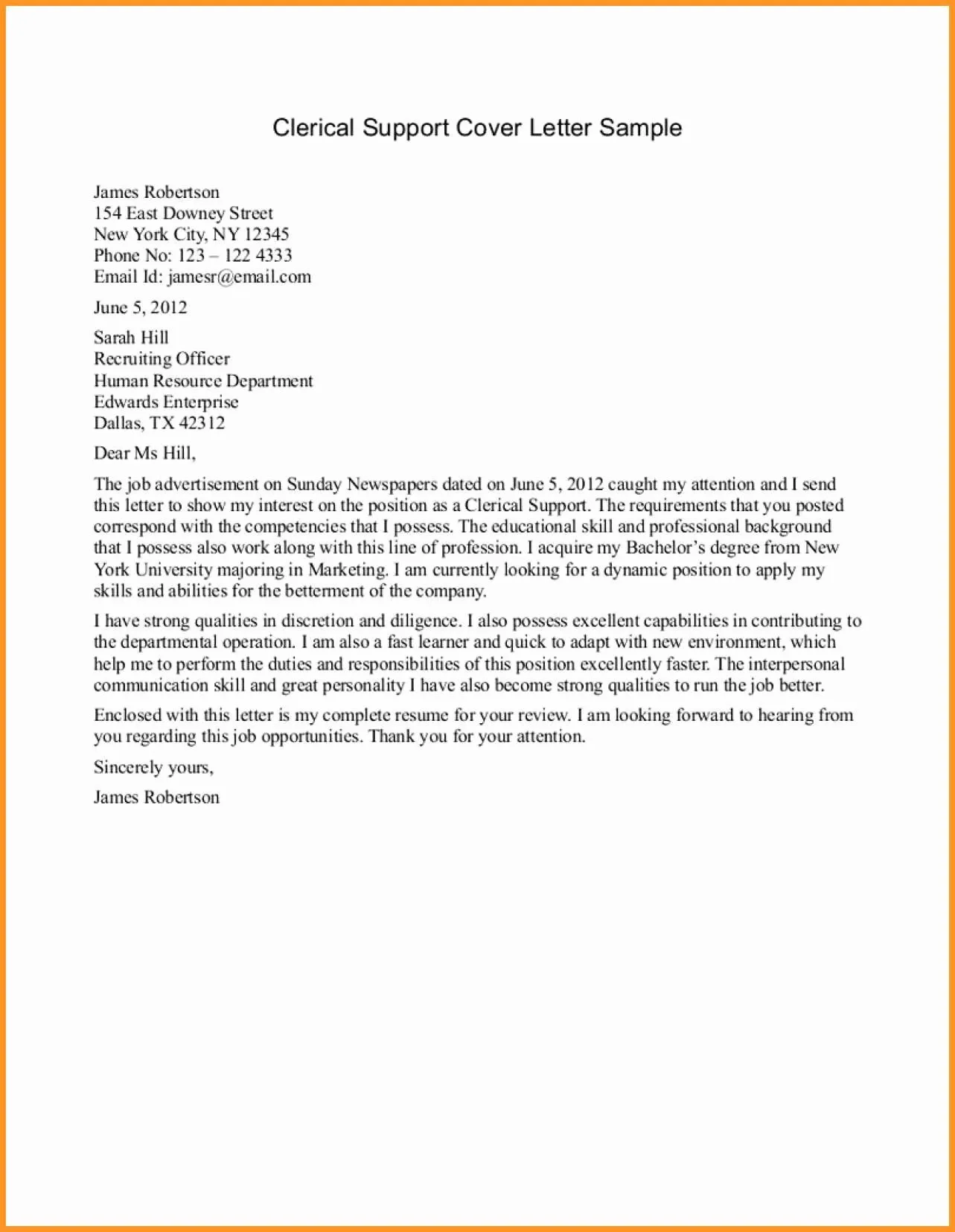
When applying for a clerical position with specific skill requirements, tailor your cover letter to highlight those skills. If the job description mentions specific software proficiencies or industry-related knowledge, make sure to showcase your relevant experience. Mention your experience using specific office tools such as Microsoft Office, data entry, or phone handling. Show that you understand the unique requirements of the role. Make sure you understand the job requirements, and then provide examples of your experience in these areas. Focus on demonstrating a clear understanding of the job duties and the ability to perform these tasks effectively. Demonstrating these skills will make your application more compelling.
Tips for Optimizing Your Clerical Cover Letter
Optimizing your clerical cover letter is crucial for ensuring it effectively showcases your qualifications and increases your chances of getting hired. This involves paying close attention to detail, ensuring clarity, and using best practices in writing and formatting. A well-optimized cover letter is tailored to the specific job requirements, highlights your skills, and demonstrates your enthusiasm for the role. By following these tips, you can create a cover letter that effectively grabs the attention of hiring managers and makes a positive impression. This is your opportunity to make a great first impression, so make sure every aspect of the letter supports your goals and showcases your strengths.
Proofreading and Editing
Proofreading and editing your cover letter is essential to ensure that your writing is clear, concise, and free of errors. Proofreading and editing can significantly enhance your cover letter. Typos and grammatical errors can reflect poorly on your attention to detail, so take the time to meticulously review your document. Proofread your cover letter multiple times, and consider using a grammar checker or asking a friend or colleague to review it. Ensure your language is appropriate, and your tone is professional throughout the letter. Use a grammar checker to detect errors. By carefully proofreading your letter, you ensure that your skills and qualifications are presented professionally.
Formatting and Readability
Formatting and readability are key to making your cover letter easy to read and visually appealing. Use a professional font such as Arial or Times New Roman, with a font size between 10 and 12 points. Maintain consistent formatting throughout the document, including margins, spacing, and bullet points. Use clear and concise language, and avoid long, complex sentences. Break up large blocks of text into smaller paragraphs to improve readability. Proper formatting and readability make it easier for the hiring manager to scan your cover letter, quickly grasp your key qualifications, and appreciate your value. Make sure you are using clear and effective language.
Keyword Optimization
Keyword optimization is a critical aspect of writing a successful clerical cover letter. Carefully review the job description and identify the keywords and phrases the employer uses to describe the required skills and qualifications. Integrate these keywords naturally throughout your cover letter, especially in the introduction, skills section, and closing. This helps to ensure that your cover letter is noticed by applicant tracking systems and demonstrates your understanding of the job requirements. Use relevant keywords. By incorporating relevant keywords, you can optimize your cover letter and increase your chances of landing an interview. Keywords are critical to ensuring your cover letter reaches the right people.
Common Mistakes to Avoid
Avoiding common mistakes is crucial for presenting a professional and effective clerical cover letter. Be mindful of these pitfalls to make your application stand out. By avoiding these common mistakes, you can ensure that your cover letter effectively highlights your qualifications and significantly increases your chances of getting hired. Addressing these pitfalls will enhance the overall impact of your cover letter.
Ignoring the Job Description
One of the most common mistakes is failing to carefully read and address the job description. Tailor your cover letter to the specific requirements outlined in the job posting. Make sure to use the same language and keywords that the employer uses to describe the role, showcasing your understanding of the job responsibilities and your relevant skills. Always prioritize the requirements highlighted by the employer. Show that you understand what the employer is looking for by directly addressing the key skills and qualifications mentioned in the job description.
Using Generic Templates
Avoid using generic cover letter templates without customizing them. These templates often lack the personalized touch needed to impress hiring managers. Generic templates don’t allow you to highlight your unique strengths, making your application less impactful. Tailoring your cover letter to the specific job and the company’s needs is essential. Customize the content to align with the job requirements, show your enthusiasm, and make sure your skills and experience are relevant. Use these templates as inspiration, but always personalize them to reflect your experience and suitability for the role.
Typos and Grammatical Errors
Typos and grammatical errors can undermine your credibility and professionalism. Proofread your cover letter carefully before submitting it. Ensure that your writing is clear, concise, and free of any errors. Asking a friend or colleague to review your letter can also help you catch any mistakes you might have missed. A polished, error-free cover letter demonstrates attention to detail and a commitment to quality. By proofreading thoroughly, you guarantee a professional impression that strengthens your chances of a successful application.
Conclusion
Writing a compelling clerical job cover letter is a critical step in your job search. By understanding the key components, following the tips for optimization, and avoiding common mistakes, you can create a cover letter that effectively showcases your qualifications and increases your chances of getting hired. Focus on presenting your skills, experience, and enthusiasm in a way that is tailored to the specific job and company. Proofread and edit your letter carefully, and always customize it to demonstrate your value to the employer. With a well-crafted cover letter, you can confidently make a strong first impression and land your dream clerical job. Good luck with your job application, and remember to highlight your skills, experience, and enthusiasm in your cover letter.
